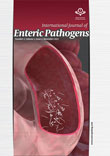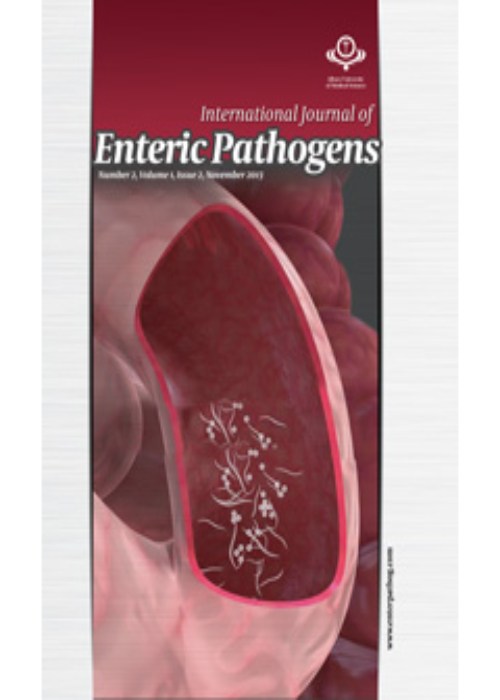فهرست مطالب

International Journal of Enteric Pathogens
Volume:3 Issue: 3, Aug 2015
- تاریخ انتشار: 1394/06/20
- تعداد عناوین: 6
-
-
Page 1BackgroundUrinary tract infections (UTIs) are one of the most common bacterial diseases. The etiological agents and emergence of antimicrobial resistance UTIs vary according to time and geographical region..ObjectivesThe present study aimed to determine the prevalence of etiological agents of UTIs and determine their antimicrobial susceptibility pattern to locally available antibiotics..Patients andMethodsThis descriptive cross-sectional study was conducted within six months on all patients with clinical symptoms of UTI who referred to Nemazee Teaching hospital, Shiraz, Iran. Clean catch midstream urine samples were collected and cultured on appropriate media in a short time as possible. Conventional bacteriological methods were followed for the isolation and identification of the bacteria. Antimicrobial susceptibility profiles were determined by locally available antibiotics by using disk diffusion method in accordance with CLSI recommendation..ResultsIn this study, from overall 9991 specimens analyzed 848 (8.5%) culture had significant bacterial growth. Of the total positive cultures, 500 (59%) cases were female. Escherichia coli (50.6%) was the predominant gram-negative isolated pathogen followed by Klebsiella spp. and Enterobacter spp., respectively. Enterococcus isolates (11.2%) was the most isolated gram-positive cocci. Nitrofurantoin (80.9%), gentamycin (77.9%) and amikacin (65.3%) had the most in-vitro antibacterial effect on E. coli isolates as the predominant cause of UTIs..ConclusionsThe results of regional assessments, such as our study, provide not only useful information for prescription of more effective empirical therapy, but also good epidemiological background for comparison of our situation with other regions.Keywords: Urinary Tract Infections, Microbial Sensitivity Tests, Escherichia coli, Pediatrics, Age
-
Page 2BackgroundDuring the last decade, the prevalence of insect borne diseases due to contaminated food as well as the outbreaks of diseases due to enterotoxin-producing Staphylococcus aureus (ETSA) strains has increased.ObjectivesThis study was conducted to determine the prevalence rate, enterotoxigenecity, and antimicrobial resistance of S. aureus isolated from M. domestica collected from the residential areas of nine districts broiler farms in Zabol, Iran.Materials And MethodsThe flies were captured with a sterile nylon net and washed twice with distilled water. The contents were streaked onto selective media and S. aureus was identified using the conventional biochemical tests. Antimicrobial susceptibility testing was performed using CLSI guideline. Staphylococcal enterotoxins (SEs), SEA, SEB, SEC and SED, was detected by the reverse passive latex agglutination (PRLA) method. Coagulase typing was performed with coagulase typing kit.ResultsA total of 87 (17%) S. aureus was isolated from 450 samples. The ability to synthesize staphylococcal enterotoxins (SEs) was determined in 62 of 87 (71%) isolates. SE type B was the most common enterotoxin found in the isolated S. aureus (45%), followed by SE type A (26%), SE type C (5%), SE type D (8%), SEA + SEC (7%) and SEA + SEB (7%). Among the antibiotic tested, Penicillin was the most resistant antibiotic tested. Sixty seven percent of isolates belonged to coagulase type III, VI, VII, VIII, IV, and V.ConclusionsOur results suggest that S. aureus, including ETSA, is being carried by house flies such as M. domestica and may contribute to the spread of pathogenic isolates, with an impact on public health.Keywords: Houseflies, Staphylococcus aureus, coagulase, Drug Resistance, Microbial
-
Page 3BackgroundCryptosporidium, a coccidian parasite, is the causative agent of watery diarrhea in humans and animals. The disease is mostly self-limiting in immunocompetent individuals, yet severe infection can occur in children and immunocompromised patients. The parasite is mostly transmitted to humans by water, yet it can also be transmitted by soil.ObjectivesThe present study aimed to determine soil contamination rate of parks of Isfahan, Iran, with Cryptosporidium spp. oocysts.Materials And MethodsIn this cross-sectional study, 140 soil samples from 28 public parks of 14 regions of Isfahan (central Iran) were collected during summer 2014. The soil samples were concentrated using the sucrose floatation technique, which was followed by preparation of microscopic slides. The slides were stained by the modified Ziehl-Neelsen staining method and were examined microscopically for presence of Cryptosporidium spp. oocysts using 100X oil immersion objective.ResultsCryptosporidium spp. oocysts were observed in 31 out of 140 soil samples (22.14%). Also, all 14 regions (100%) and 17 out of 28 public parks (60.71%) were contaminated with Cryptosporidium spp. oocysts.ConclusionsDespite the climate temperature of Isfahan city, the soli of parks were highly contaminated with Cryptosporidium spp.Keywords: Oocyst, Soil, Iran, Cryptosporidium
-
Page 4BackgroundSporozoan protozoa and enteroparasites cause gastroenteritis. Sporozoa are the major cause of self-limiting diarrhea in immunocompetent patients, however they cause serious diseased in patients with immunosuppression.ObjectivesThe current study aimed to identify the prevalence of sporozoa and enteroparasites among patients with gastroenteritis referred to the healthcare centers in seven provinces of Iran.Patients andMethodsIn this cross-sectional study, 4200 stool samples were randomly collected from patients with gastroenteritis in the selected hospitals of Gilan, East Azerbaijan, Qazvin, Kurdistan, Mazandaran, Tehran and Khorasan-e-Razavi provinces. Primarily samples were examined directly for enteroparasites. The samples were then filtered and concentrated using Paraseb kit. The pellets were fixed, stained by different assays including acid fast staining, Auramin Phenol Fluorescence, Giemsa and light microscopy.ResultsThe results revealed the overall rate of infection, 3.86% (163 cases), as an indicator of parasitic enteropathogens in Iran. Among the provinces, Khorasan-e-Razavi and Mazandaran with 8.83% (53 cases) and 0.34% (2 cases) showed the highest and lowest rates of infection, respectively. The frequencies of sporozoa including Cryptosporidium, Microsporidium, Isospora and Cyclospora spp. were 0.1%, 0.1%, 0.07% and 0.02% respectively. Among the parasites, Giardia lambelia, Taenia saginata and Hookworms with 1.78% and 0.02% had the highest and lowest rates of infection, respectively. Regarding the age groups, the highest and the lowest rates of infection were in 0 - 10 (48%) and 41 years old and above (6.7%) groups, respectively.ConclusionsDespite relatively low prevalence of sporozoa, giardiosis is the most prevalent agent for gastroenteritis amongst 3.86% of parasitic infections in Iran. The current study confirmed the abundance of infection in warm and wet seasons, and more frequency of infections among children than adults. Meanwhile, geographical and agricultural conditions, seasonal rainfall, abundance of water, and animal contact are key factors affecting sporozoan infections.Keywords: Cryptosporidium, Isospora, Microspora, Cyclospora, Gastroenteritis
-
Page 5BackgroundEscherichia coli can be categorized into four major phylogenetic groups (A, B1, B2, and D) based on presence or absence of three markers including two genes (chuA and yjaA) and an anonymous DNA fragment designated TSPE4.C2. Also, these groups are divided into seven phylogenetic subgroups A0, A1, B1, B22, B23, D1, and D2.ObjectivesThis study aimed to determine the distribution pattern of phylogenetic groups in Shiga Toxin-Producing Escherichia coli (STEC) and Enteropathogenic Escherichia coli (EPEC) isolated from asymptomatic goats in Kerman city, Iran.Materials And MethodsTwo hundred and fifty fecal samples were obtained from healthy goats. All isolates were subjected to detection of phylogenetic markers chuA, yjaA and DNA fragment TspE4.C2 and virulence genes stx1, stx2 and eae.ResultsIn summary, among all isolates phylo-group B1 was the most prevalent (57.6%) and other phylo-groups were A1 (20.4%), A0 (18.4%), D1 (2.8%), and B22 (0.8%). There was no isolate in B23 and D2 subgroups. Fifty samples (20%) possessed at least one of the tested virulence genes: stx1 (12%), stx1/stx2 (4%), eae (2.8%), stx1/eae (0.8%), and stx2 (0.4%). Thus, 41 (16.4%) STEC, 7 (2.8%) EPEC and 2 (0.8%) Enterohemorrhagic Escherichia coli (EHEC) strains were isolated and allocated into four phylogenetic subgroups A0 (16%), A1 (12%), B1 (68%), and D1 (4%).ConclusionsBased on 250 fecal samples obtained from goats in industrial slaughterhouse of Kerman City, goats may be a potential reservoir of STEC in Kerman and B1 followed by A are the most prevalent phylogenetic groups among STEC and non-STEC isolates in this study.Keywords: Phylogeny, Shiga Toxin, Producing Escherichia coli, Enteropathogenic E. coli
-
Page 6BackgroundThe epidemiology of Uropathogenic Escherichia coli (UPEC) in urban and rural communities in Iran was never investigated prior to this study.ObjectivesThe aims of this study were to detect the frequency of virulence genes and determine the antimicrobial susceptibility and phylogenetic background of Escherichia coli isolates collected from urban and rural communities.Materials And MethodsA total of 100 E. coli isolates were collected from urine samples of patients with urinary tract infections (UTIs) residing in two different locations, and confirmed by current biochemical tests. The phylogenetic groups were determined by the triplex-polymerase chain reaction (PCR) method, and multiplex PCRs were used to detect eight Vf genes (fimH, iucD, irp2, hlyA, ompT, iha, iroN, and cnf1). The susceptibility profile of E. coli isolates was determined by the disk diffusion method.ResultsNinety-five percent of UPEC showed at least one of the virulence genes, the most prevalent being fimH (95%), followed by irp2 (89%), iucD (69%), ompT (67%), iroN (29%), and iha (29%). The various combinations of detected genes were designated as virulence patterns. Phylogenetic groups, B2 (55%) and D (22%), comprised the majority of isolated strains. Phenotypic tests showed that 92%, 74% and 71% of the isolates were resistant to ampicillin, ceftizoxime and cefixime, respectively.ConclusionsThese findings indicate that the UPEC isolates had eight virulence factors with high frequencies. Moreover, these results suggest a direct connection between virulence factors, gene diversity, phylogenetic background, and antimicrobial resistance in UPEC isolates.Keywords: Phylogenetic Groups, Multiplex PCR Uropathogenic, Escherichia coli


